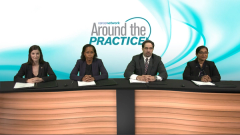
Key Updates from the GRIFFIN Trial in Multiple Myeloma
Experts on multiple myeloma discuss recent updates from the GRIFFIN trial on patients with transplant-eligible multiple myeloma.
Episodes in this series

Transcript:
Al-Ola Abdallah, MD: Leyla, let’s start with you. The biggest question is talking about the GRIFFIN trial. Since the GRIFFIN trial results came out, there’s no doubt that we’re seeing a shift from triplet therapy to quadruplet therapy. RVd [lenalidomide, bortezomib, dexamethasone] used to be the standard of care, but now we’re adding daratumumab to RVd [lenalidomide, bortezomib, dexamethasone]. Can you give us an update about the efficacy of adding daratumumab to the triplet therapy?
Leyla O. Shune, MD: That’s a very good question, Dr Abdallah. GRIFFIN is a phase 2 trial looking to add daratumumab to our standard of care, RVd [lenalidomide, bortezomib, dexamethasone]. The trial had updates at ASH [American Society of Hematology Annual Meeting] 2022, which is a 4-year follow-up. It showed that patients diagnosed with multiple myeloma were randomized to daratumumab–RVd [lenalidomide, bortezomib, dexamethasone] vs RVd [lenalidomide, bortezomib, dexamethasone] induction, followed by autologous transplant, followed by consolidation, and then onward to daratumumab-Revlimid [lenalidomide] vs standard-of-care Revlimid maintenance. In that update, at 4 years, the daratumumab–RVd [lenalidomide, bortezomib, dexamethasone] arm showed improved PFS [progression-free survival], almost double what the standard-of-care RVd had [lenalidomide, bortezomib, dexamethasone]. When they looked at subgroup analysis, daratumumab–RVd [lenalidomide, bortezomib, dexamethasone] showed superior stringent CR [complete response] rates and MRD [minimal residual disease] negativity across the board. This was among patients who are older than age 65 [years old] who are African American with high-risk multiple myeloma. These patients have 1 cytogenetic risk factor and have extramedullary disease.
Daratumumab, Revlimid, Velcade [bortezomib], dexamethasone has shown significant improvement in progression-free survival among patients with newly diagnosed transplant-eligible myeloma across risk categories. However, this is a phase 2 trial, and we don’t have OS [overall survival] data to support this yet. There are studies being conducted similar to GRIFFIN in a phase 3 setting, and we’re looking forward to hearing the results from these studies. In the interim, we and our community doctors have started adopting daratumumab, Revlimid, Velcade, dexamethasone as induction therapy for patients who have a newly diagnosed transplant-eligible multiple myeloma.
Al-Ola Abdallah, MD: I like that idea. We’re adapting that. I’ve made that comment about the GRIFFIN trial, that since it came we’re doing more induction therapy with 4 drugs. One thing I notice in the real world is that post-transplant, we’re not following the GRIFFIN trial. In standard-risk myeloma, a lot of community doctors tell me they’re following guidelines from other institutions. They switch to maintenance therapy Revlimid as the backbone for standard-risk [disease]. If [patients have] high-risk [disease], they switch them to Velcade and Revlimid.
I’m a little surprised by that. If we believe daratumumab is that effective, we have to give it a chance in maintenance therapy. Are we going to lose that PFS and maybe OS if we drop the daratumumab up front? It’s too early to make any modification without strong evidence. One of my biggest concerns is seeing 4 cycles of only daratumumab, and then we’re dropping it. I’m not seeing a lot of physicians following the GRIFFIN trial, especially in high-risk myeloma. That’s 1 thing in regard to the GRIFFIN trial.
Transcript edited for clarity.
Newsletter
Stay up to date on recent advances in the multidisciplinary approach to cancer.




















































































